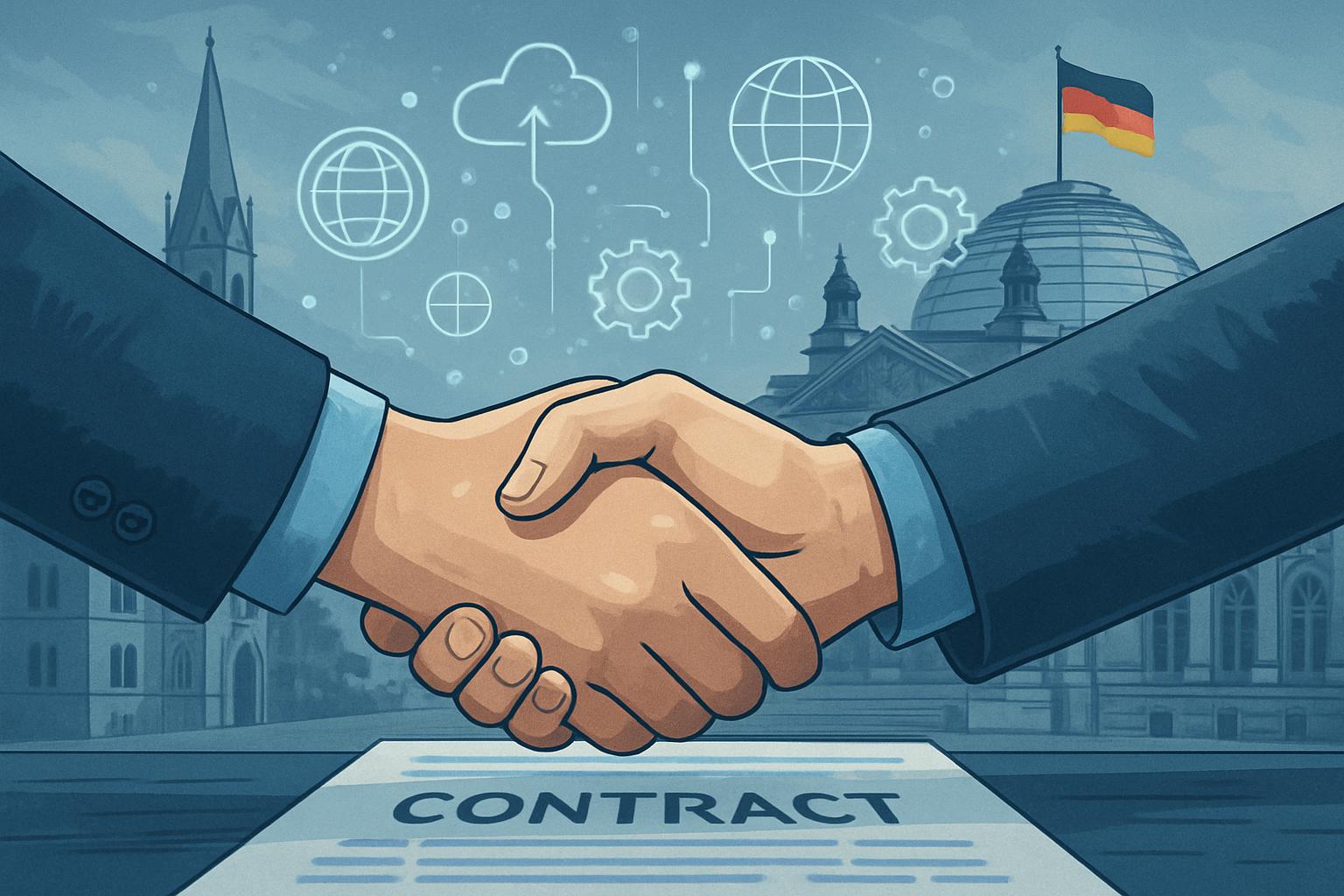
AI CERTS
1 day ago
EPAM Tops German IT Sourcing Rankings, Clients Praise Innovation
This article dissects the result, contrasting satisfaction metrics with revenue-based lists. It examines why AI-Native capabilities resonate with buyers. Moreover, it explains what the findings mean for procurement teams overseeing IT Sourcing strategies. Practical insights and certification guidance appear throughout. Readers will leave prepared to benchmark providers and safeguard delivery outcomes.
German IT Sourcing Overview
Historically, German enterprises focused on scale when selecting technology partners. However, accelerating transformation programs shifted attention toward quality indicators. Whitelane Research captured that pivot through its annual voice-of-customer survey. The study compares more than 1,000 provider relationships across innovation, delivery, and transformation categories.

In 2025, over 300 senior decision makers participated, representing the nation’s largest spenders. Furthermore, respondents represented banking, automotive, and manufacturing verticals. Their feedback now informs procurement playbooks more than traditional analyst quadrants. Consequently, rankings like Whitelane influence boardroom debates about partner viability. These fundamentals set the stage for EPAM’s performance, explored in the following section.
Survey scope and methodology explain why satisfaction scores matter more than headline revenue tables. Meanwhile, those dynamics prepare readers for the specific findings ahead.
Whitelane Study Key Findings
Whitelane’s 2025 German report crowned EPAM an Exceptional Performer across five measured dimensions. Innovation scored 82%, while service delivery reached 83%. Additionally, application services tied at 81%, with transformation hitting 77%. Overall, general satisfaction stood at 80%, firmly above the market average. These metrics positioned EPAM as a top IT Sourcing partner for German enterprises seeking reliability and creativity.
- Innovation: 82% rating
- Service Delivery Quality: 83%
- Application Services: 81% (joint)
- Transformation Projects: 77%
Consequently, EPAM outranked several legacy incumbents across perception of engineering excellence. Alex van den Bergh highlighted the firm’s role in driving transformational change through product engineering. Furthermore, 90% of respondents signaled plans to expand AI investments, favoring AI-Native vendors. Such context underscores why the company’s automation expertise resonates strongly. Statistical evidence confirms EPAM’s leadership on capabilities that clients value most. Therefore, the findings provide a benchmark for comparing rival providers.
Revenue Rankings In Contrast
Performance rankings differ when analysts shift from satisfaction to revenue tables. In contrast, the 2025 Lünendonk list focuses on domestic turnover rather than perceived quality. Providers like adesso, msg, Materna, and T-Systems dominate that leaderboard. EPAM appears lower because its German revenue reached $51.692 million during Q1 2025. However, revenue scale alone cannot predict future IT Sourcing success for complex transformation programs.
Procurement teams should, therefore, weigh both datasets before finalizing shortlist decisions. Satisfaction studies reveal operational risk, while turnover lists reveal capacity. Together, they form a balanced market picture for stakeholders.
Whitelane and Lünendonk answer different strategic questions for buyers. Consequently, combining them reduces blind spots when selecting partners.
Drivers Behind High Scores
Several structural advantages elevate the firm’s ratings among German respondents. First, the company combines global engineering depth with local consulting talent. Moreover, its AI-Native toolkits accelerate prototype development and reduce deployment cycles. Second, agile delivery models align with strict data privacy regulations prevalent in Germany. Third, continuous knowledge transfer programs raise Client Satisfaction by empowering in-house teams. Whitelane data shows that personal engagement from senior architects correlates strongly with perceived innovation. Consequently, the firm wins repeat business despite competing against larger domestic vendors.
- Engineering-first culture encourages experimentation
- AI-Native accelerators cut project latency
- Transparent governance enhances Client Satisfaction
These factors collectively sustain top IT Sourcing evaluations year after year. Strategic alignment with buyer priorities underpins the company’s statistical dominance. Therefore, understanding these levers helps other vendors refine their competitive posture.
Key Implications For Buyers
Procurement leaders face rising accountability for transformation outcomes and cost discipline. Therefore, they should scrutinize both quantitative ratings and qualitative project evidence. When negotiating, insist that the vendor maintains AI-Native resources onshore during critical sprints. Meanwhile, benchmark Client Satisfaction targets against Whitelane medians to enforce measurable governance. Include exit clauses that protect intellectual property if Germany regulatory shifts demand provider changes.
- Request latest Whitelane rating tables
- Compare delivery quality against revenue scale
- Align AI-Native support with security policies
Implement a quarterly scorecard covering cost, risk, innovation, and IT Sourcing flexibility. Structured governance keeps projects within tolerance bands. Consequently, disciplined oversight converts high ratings into tangible business value.
Certification And Skills Path
Talent readiness often determines how quickly enterprises realize promised benefits. Therefore, upskilling initiatives should accompany vendor onboarding. Professionals can enhance their expertise with the AI Learning Development™ certification. Moreover, the firm offers project shadowing that reinforces classroom knowledge with real-world practice. Such exposure fosters mastery of emerging design patterns. Such programs boost Client Satisfaction by creating shared vocabulary between internal teams and consultants. Including certification milestones inside contracts strengthens Germany compliance with evolving skills frameworks. That approach also aligns with IT Sourcing policies emphasizing continuous improvement. Knowledge investments de-risk complex transformation workloads. Meanwhile, certified staff accelerate sustainable capability transfer.
Market Outlook For 2026
Economic signals suggest cautious optimism among German CIOs entering 2026. Nevertheless, 29% plan to increase external spend despite macro uncertainty. Surveyed executives forecast double-digit productivity gains from successful automation initiatives. Whitelane expects AI-Native adoption rates to accelerate as generative tooling matures. Consequently, vendors offering end-to-end engineering will gain share across Germany. The firm should benefit if it maintains delivery consistency. Procurement teams, therefore, must refresh IT Sourcing frameworks to capture future value. Meanwhile, regulatory scrutiny may intensify around data residency and sustainability. Tracking Client Satisfaction will remain critical as the service landscape evolves.
Overall, German demand appears resilient yet selective. Therefore, balanced scorecards will help enterprises navigate an increasingly crowded provider ecosystem.
In summary, Whitelane’s data confirms that quality, innovation, and AI-Native capabilities now shape competitive advantage. Moreover, revenue size alone fails to capture partnership value. Consequently, buyers should blend satisfaction surveys with financial indicators while strengthening internal skills. Explore certifications, update IT Sourcing governance, and engage informed partners to secure transformation success.



